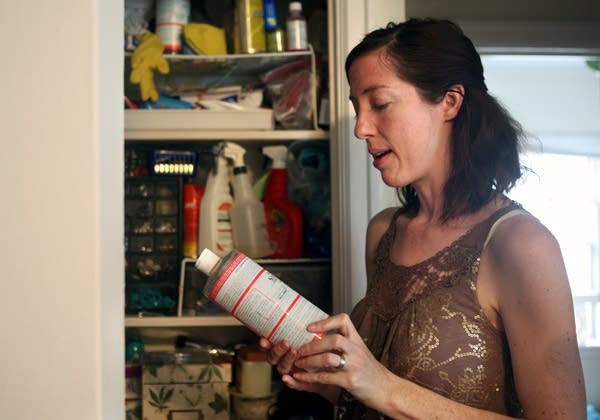State setting health standards for emerging contaminants
Go Deeper.
Create an account or log in to save stories.
Like this?
Thanks for liking this story! We have added it to a list of your favorite stories.

The Minnesota Department of Health is taking a closer look at a variety of chemicals that make their way into the water supply.
Federal and state regulators have already placed limits on many contaminants found in drinking water, among them lead and mercury. But health officials are turning their attention to other chemicals that are not widely known, including those in fragrances, prescription drugs and bug spray.
Scientists know that many of them are a problem, but determining when they become a public health threat is the next step, said Deb Swackhamer, an environmental chemist at the University of Minnesota.
"We don't have the actual detailed toxicological data that says this compound at this dose causes this problem so we're going to regulate it at that dose," said Swackhamer, chairman of the Environmental Protection Agency's Science Advisory Board. "That kind of data takes an enormous amount of effort; it takes millions of dollars to collect."
Turn Up Your Support
MPR News helps you turn down the noise and build shared understanding. Turn up your support for this public resource and keep trusted journalism accessible to all.
Health department scientists aren't doing any of their own testing. Instead, using $1.7 million dollars from the state's Legacy Amendment, they're poring over all the data they can find. Based on existing studies, they'll decide what amount of various contaminants presents too much risk to be in Minnesotans' drinking water.
Another challenge Swackhamer said, is persuading the public to care when most of the substances have little or no immediate effect.
"That's what's so hard to communicate to people," she said. "If you take a glass of water and get hives, you know you shouldn't be drinking that water, but in this case you're taking in the water and you have to be thinking about literally the next generation."

Nancy Brown is one parent who does care. She's gone a lot farther than most to eliminate potentially toxic products from her family's Minneapolis apartment. All of the food she feeds her three sons is organic.
Brown also cares about the packaging the family's food comes in. After reading about some chemicals found in the cling plastic wrap grocery store delis often use, she asked her local co-op to wrap her cheese in butcher paper instead.
At home, Brown avoids plastic water bottles and food containers, and uses glass instead.
"I haven't heated anything in plastic for years," she said.
Brown said plastic can contain chemicals like bisphenol A, or BPA, which is found in some water bottles and the rubbery lining in food cans. Studies have shown the chemical is an endocrine disrupter that can interfere with the body's natural hormones. A new state law bans BPA in baby bottles and children's sippy cups.
But Brown said there is no way to eliminate all the potential hazards, and she admits her water faucet is one place where the risk is unknown.
"We drink tap water," she said. "I have no doubt that there's contaminants we're drinking in our water."

Brown looked into a filtering system called reverse osmosis. But it's expensive and uses a lot of water.
"It could be a full time job — protecting your children from toxins — and I don't think any of us should have to do that job," she said. "We just need better water for everybody."
Brown is on the board of Preventing Harm Minnesota, a group that aims to reduce toxins children are exposed to. The group nominated BPA for further study by the health department.
So far, the contaminants of emerging concern program has developed guidance for 10 different contaminants, including a fragrance, a disinfectant and a flame retardant. Health officials have also issued recommendations on acetaminophen, which is in Tylenol, and an anticonvulsant prescription drug. This year BPA is on the list, along with several types of phthalates, which are also found in plastics.
Michele Ross, who coordinates the contaminants of emerging concern program, said it's sometimes difficult for the public to understand why some substances are being considered harmful.
"Especially with a chemical like a pharmaceutical where it's beneficial, obviously to whoever's taking it, who's being prescribed it, they need to take it. The amount that we're finding in water is so much lower than what you would take if you were actually prescribed it," she said. "But then again it goes back to that, well I'm not prescribed it, so how does it affect me?"
Environmental toxicologist Pam Shubat, who supervises the state health department's health risk assessment program, said guidance for some chemicals wouldn't exist without Minnesota's work.

"We know how important it is to develop guidance when we can't rely on guidance from the federal government or guidance from other states," Shubat said.
The health department was doing some work even before receiving money from the Legacy Amendment. For example, health officials came up with guidance on perfluorinated chemicals, or PFCs, which were being found in drinking water in the east metro area.
"This is such a basic question that whether or not they turn out to be harmful, most people understand that we do need to have an answer," Shubat said. "People are going to drink this contaminant. We do need to answer the question."
As water testing becomes more sophisticated, health officials will be able to use their research results to limit our exposure to contaminants in the future.
Ten contaminants for which the MDH has developed guidance:
Minnesota's Legacy Amendment has allowed the Minnesota Department of Health to create a program looking at what they call contaminants of emerging concern. The program has received about $1.7 million so far.
In the next couple of years, health officials plan to look at bisphenol A (BPA), which is found in some water bottles and the rubber lining in food cans, as well as phthalates, which are found in plastics. Below is the list of the 10 contaminants for which the health department has issued guidance as part of the program.
Acetaminophen: A pain and fever medication, most commonly found in Tylenol. It's been found in Minnesota waters, but at much lower concentrations than the maximum recommended by Minnesota health officials.
AHTN or Tonalide: A musky fragrance found in personal care and cleaning products. It's been found in Minnesota waters, but at much lower concentrations than the maximum recommended by Minnesota health officials.
Carbamazepine: A medication used to help control seizures. It's been found in Minnesota waters (not drinking water) at lower concentrations than the maximum recommended by Minnesota health officials.
DEET: An ingredient in many insect repellents. It's been found in Minnesota drinking water but at a concentration 3,000 times less than the maximum concentration recommended by Minnesota health officials.
1,4-Dioxane: Found in personal care and cleaning products. It's been found in Minnesota groundwater at higher concentrations than health officials recommend, but they say they expect the contaminant would be present in much lower concentrations in drinking water.
Metribuzin Degradates: Metribuzin is an herbicide used to control weeds in potato, corn and soybean production. It's been found in Minnesota waters at lower concentrations than recommended for drinking water.
Pyraclostrobin: A pesticide used to prevent the growth of fungi. It wasn't found in surface water or groundwater during a recent Minnesota Department of Agriculture study.
Tris(2-Chloroethyl)phosphate (TCEP): A fire retardant added to plastics, foams and textiles. It's been found in drinking water but at concentrations 80 times lower than the maximum recommended by Minnesota health officials.
1,2,3-Trichloropropane (1,2,3-TCP): A chemical once used in pesticides that's also used to make other chemicals. It's been found in Minnesota waters above health officials' recommended concentration level (a closed landfill site) but better monitoring techniques would be needed to detect in other waters.
Triclosan: An antimicrobial agent added to soaps and cleaners. It's been found in Minnesota waters at low concentrations but has not been found in drinking water or groundwater.
Source: Minnesota Department of Health Contaminants of Emerging Concern program.



